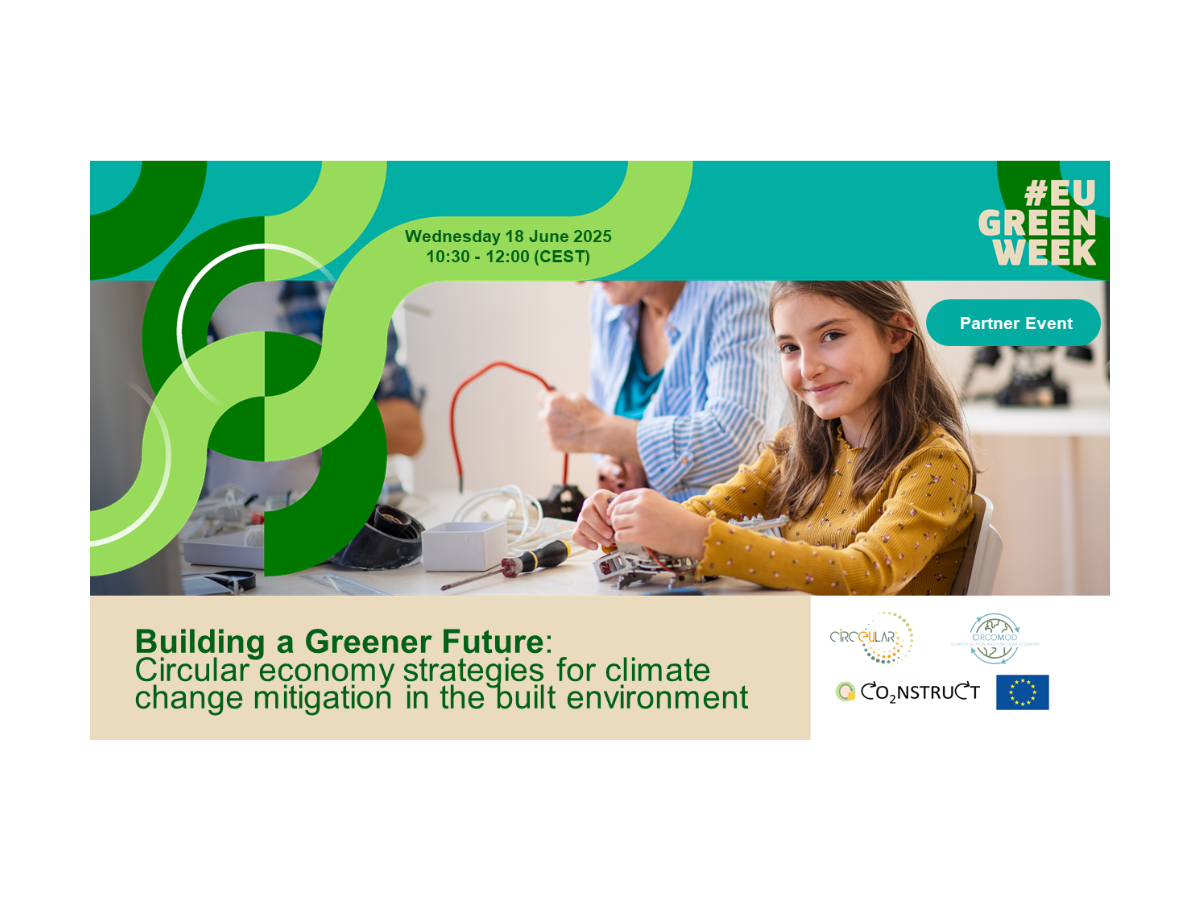
Webinar, June 18th, 2025, 10.30 am – 12.00 pm CEST
How can the circular economy in the built environment drive climate change mitigation? The building sector is a major contributor to resource consumption and GHG emissions, underscoring the urgent need for sustainable and circular solutions. Transitioning to a circular economy model, through the reuse of materials, sustainable construction practices, and improved renovation strategies, can play a key role in climate change mitigation and the reduction of environmental impacts.
During the EU Green Week 2025, on June 18, experts and stakeholders from three Horizon Europe projects – CIRCOMOD, CircEUlar, and CO2NSTRUCT – will discuss innovative circular approaches that can transform the sector.
The session will focus on policy frameworks, circular pathways, and consumer behavior, highlighting good practices and research findings that support the transition to circularity. The circular pathways will look at strategies that the sector as a whole system can implement taking into account societal, business and policy needs.
Across presentations and discussions, we will cover:
- Policy frameworks – Building standards, funding schemes and regulatory drivers
- Consumer behaviour – How building user choices affect sustainability
- Business pathways – Results from key research projects on sustainable materials use
Starting with circular pathways of material use in buildings and transport infrastructure, the event will then zoom into construction material value chains and conclude with the design and use of household appliances. The event is open to all interested parties but will be most relevant to policy-makers, industry representatives, researchers, and professionals engaged in sustainable construction, urban planning, circular economy initiatives, and environmental policy. Participants will gain insights into the research findings to support the implementation of circular economy principles in the building sector.
Agenda
Moderator: Sara Giorgi (T6 Ecosystems)
10:30-10:40 | Welcome and Introduction
CircEUlar, CIRCOMOD, CO2NSTRUCT
10:40-11:00 | Circular pathways for the built environment
Peter Berrill (Leiden University)
Construction materials used in buildings and transport infrastructure account for around half of GHG emissions from global material production. These structures provide essential services such as shelter and mobility, key to Decent Living Standards and societal well-being. Buildings hold the largest share of in-use anthropogenic stocks, while transportation infrastructure accounts for 30-50%. As developed nations face ageing infrastructure and emerging economies demand rapid increases in service demand, material needs for maintenance and expansion are expected to grow. We present global and European projections of material use in the built environment along with circular economy targets, assessing how CE strategies can influence material pathways to support climate change mitigation.
11:00-11:20 | A value chain approach to a low carbon circular economy for flat glass
Sofia Simoes (LNEG)
Decarbonizing the construction sector is key to achieving carbon neutrality, and CE is listed as a solution. To achieve this, a holistic, value-chain approach needs to take place in order to identify where CE is making the most impact in the production of key construction materials. The European flat glass value chain will be described as an example of the most carbon-intensive construction materials: cement, steel, brick, glass, insulation and wood.
11:20-11:40 | Smarter design and use of household appliances for a circular Europe
Adriana Gómez-Sanabria (International Institute for Applied Systems Analysis)
Household appliances play a crucial role in achieving a “Clean, Competitive and Circular” Europe. By analyzing the life cycle stages of household appliances – from production and use to end-of-life, we explore how circular strategies such as eco-design, sharing, repair, reuse and recycling can help curb greenhouse gas emissions. We combine technological setups with user habits and operational practices to assess how more sustainable choices, both in design and use of appliances, can contribute to reducing emissions. This approach supports climate goals and empowers consumers to play an active role in shaping a more sustainable and circular future.
